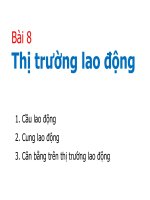- Trang chủ >>
- Đại cương >>
- Kinh tế vi mô
The theory of producer behavior production (KINH tế VI mô SLIDE)
Bạn đang xem bản rút gọn của tài liệu. Xem và tải ngay bản đầy đủ của tài liệu tại đây (2.07 MB, 64 trang )
Microeconomics
Chapter 5
Theories of Producer
Behavior - Production
1
Topics to be Discussed
The Technology of Production
Production with One Variable Input
(Labor)
Isoquants
Production with Two Variable Inputs
Returns to Scale
2011, FTU Kieu Minh
2
Introduction
Production decisions of a firm are
similar to consumer decisions
Can also be broken down into three steps
2011, FTU Kieu Minh
3
Production Decisions of a Firm
1. Production Technology
Describe how inputs can be transformed
into outputs
Inputs: land, labor, capital & raw materials
Outputs: cars, desks, books, etc.
Firms can produce different amounts of
outputs using different combinations of
inputs
2011, FTU Kieu Minh
4
Production Decisions of a Firm
2. Cost Constraints
Firms must consider prices of labor,
capital and other inputs
Firms want to minimize total production
costs partly determined by input prices
2011, FTU Kieu Minh
5
Production Decisions of a Firm
3. Input Choices
Given input prices and production
technology, the firm must choose how
much of each input to use in producing
output
Given prices of different inputs, the firm
may choose different combinations of
inputs to minimize costs
If labor is cheap, may choose to produce
with more labor and less capital
2011, FTU Kieu Minh
6
Production Decisions of a Firm
If a firm is a cost minimize, we can
also study
How total costs of production varies with
output
How does the firm choose the quantity to
maximize its profits
2011, FTU Kieu Minh
7
The Technology of Production
We can represent the firm’s production
technology in form of a production function
Production Function:
Indicates the highest output (q) that a firm can
produce for every specified combination of
inputs.
Shows what is technically feasible when the firm
operates efficiently
For simplicity, we will consider only labor (L) and
capital (K)
2011, FTU Kieu Minh
8
The Technology of Production
The production function for two
inputs:
q = F(K,L)
Output (q) is a function of capital (K) and
Labor (L)
The production function is true for a
given technology
If technology increases, more output can be
produced for a given level of inputs
2011, FTU Kieu Minh
9
The Technology of Production
Short Run versus Long Run
It takes time for a firm to adjust
production from one set of inputs to
another
Firms must consider not only what inputs
can be varied but over what period of
time that can occur
We must distinguish between long run
and short run
2011, FTU Kieu Minh
10
The Technology of Production
Short Run
Period of time in which quantities of one
or more production factors cannot be
changed.
These inputs are called fixed inputs.
Long-run
Amount of time needed to make all
production inputs variable.
Short run and long run are not time
specific
2011, FTU Kieu Minh
11
Production: One Variable Input
We will begin looking at the short run
when only one input can be varied
We assume capital is fixed and labor
is variable
Output can only be increased by
increasing labor
Must know how output changes as the
amount of labor is changed (Table 6.1)
2011, FTU Kieu Minh
12
Production: One Variable Input
2011, FTU Kieu Minh
13
Production: One Variable Input
Observations:
1. When labor is zero, output is zero as well
2. With additional workers, output (q)
increases up to 8 units of labor.
3. Beyond this point, output declines
Increasing labor can make better use of
existing capital initially
After a point, more labor is not useful and
can be counterproductive
2011, FTU Kieu Minh
14
Production: One Variable Input
Average product of Labor - Output per
unit of a particular product
Measures the productivity of a firm’s
labor in terms of how much, on
average, each worker can produce
Output
q
AP
Labor Input L
2011, FTU Kieu Minh
15
Production: One Variable Input
Marginal Product of Labor – additional
output produced when labor increases
by one unit
Change in output divided by the
change in labor
Output
q
MPL
Labor Input L
2011, FTU Kieu Minh
16
Production: One Variable Input
2011, FTU Kieu Minh
17
Production: One Variable Input
We can graph the information in Table
6.1 to show
How output varies with changes in labor
Output is maximized at 112 units
Average and Marginal Products
Marginal product is positive as long as total
output is increasing
Marginal Product crosses Average Product
at its maximum
2011, FTU Kieu Minh
18
Production: One Variable Input
Output
per
Month
D
112
Total Product
C
60
At point D, output is
maximized at 112 units
B
A
0 1
2011, FTU Kieu Minh
2 3
4
5 6
7 8
9
10 Labor per Month
19
Production: One Variable Input
Output
per
Worker
•Left of E: MP > AP & AP is increasing
•Right of E: MP < AP & AP is decreasing
•At E: MP = AP & AP is at its maximum
•At 8 units, MP is zero and output is at max
30
Marginal Product
E
20
Average Product
10
0 1
2011, FTU Kieu Minh
2 3
4
5 6
7 8
9
10 Labor per Month
20
Marginal & Average Product
When marginal product is greater than the
average product, the average product is
increasing
When marginal product is less than the
average product, the average product is
decreasing
When marginal product is zero, total product
(output) is at its maximum
Marginal product crosses average product at
its maximum
2011, FTU Kieu Minh
21
Product Curves
q
AP is slope of line from
origin to point on TP
curve
q/L
112
30
C
60
20
B
10
0 1 2 3 4 5 6 7 8 9 10
Labor
2011, FTU Kieu Minh
0 1 2 3 4 5 6 7 8 9 10
Labor
22
Product Curves
q
q
D
112
MP is slope of line tangent to
corresponding point on TP
curve
30
60
30
15
10
A
0 1 2 3 4 5 6 7 8 9 10
Labor
2011, FTU Kieu Minh
0 1 2 3 4 5 6 7 8 9 10
Labor
23
Production: One Variable Input
From the previous example, we can
see that as we increase labor the
additional output produced declines
Law of Diminishing Marginal Returns:
As the use of an input increases with
other inputs fixed, the resulting
additions to output will eventually
decrease.
2011, FTU Kieu Minh
24
Law of Diminishing Marginal
Returns
When the labor input is small and
capital is fixed, output increases
considerably since workers can begin
to specialize and MP of labor
increases
When the labor input is large, some
workers become less efficient and MP
of labor decreases
2011, FTU Kieu Minh
25









